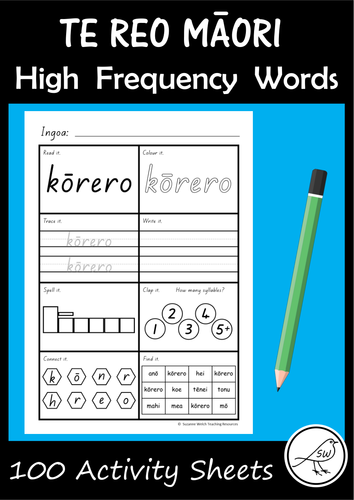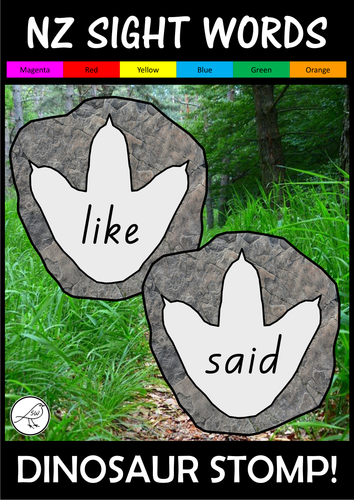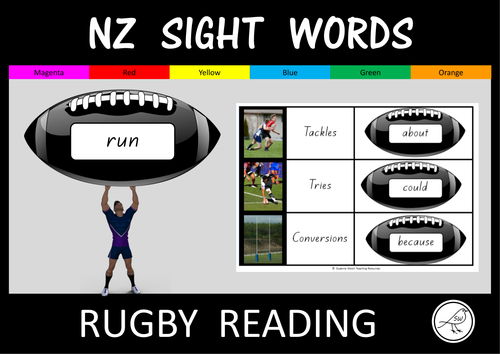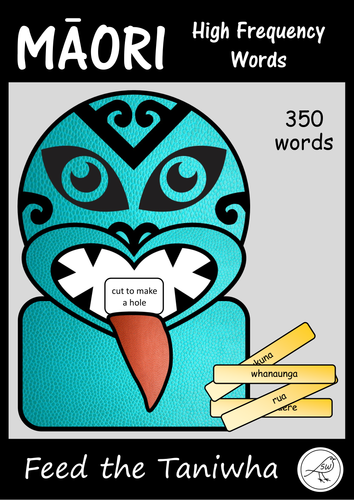
377Uploads
165k+Views
10k+Downloads
Literacy for early childhood

Te Reo Māori - 100 high frequency words - Activity Sheets
Activity sheets for 100 high frequency Māori sight words.
8 activities on each sheet:
♦ Read it
♦ Colour it
♦ Trace it
♦ Write it
♦ Clap it (How many syllables?)
♦ Spell it (write it in the ‘letter boxes’)
♦ Connect it (draw a line to connect the letters)
♦ Find it (find the word 4 times)
There is also space on the top of each sheet for your students to write their name.
The font:
The font used is ‘NZ Basic Script’. The letter shapes are the same as those recommended in the NZ Ministry of Education Handbook – ‘Teaching Handwriting’. The font used in the ‘Find it’ section is Comic Sans.
Made on A4 size paper.
Words used: High frequency word list found online on the tki website.
‘1000 frequent words of Māori – in frequency order’. The words I have used are from te to kāre (excluding whanaunga and whakaaturanga as these words were too long to fit on the template). The word ‘Māori’ has 2 activity sheets – with and without a capital letter.
This resource has been created to support Māori medium education in Aotearoa. A helpful resource for full immersion and bilingual classes.
**********************************************************************
More Te Reo Maori resources available in my store.
**********************************************************************
© Suzanne Welch Teaching Resources

New Zealand Sight Words – Dinosaur Stomp!
A fun NZ sight word resource for the Magenta to Orange levels of the colour wheel.
2 sets provided:
♦ coloured (footprint on rock, like a fossil)
♦ black and white
4 footprints per A4 size page.
Blank templates also provided (for additional words if necessary).
The font used is ‘NZ Basic Script’. The letter shapes are the same as those recommended in the NZ Ministry of Education Handbook – ‘Teaching Handwriting’.
Print and laminate the footprints that you wish to use. If you are wanting to differentiate the sets of footprints then I suggest you put a coloured dot on the back before laminating. Eg. put a red dot on the back of the ’red’ words.
Ideas for Use:
♦ Place a track of footprints around the classroom. Students walk around the track, stomping on the footprints and reading the words (in a dinosaur voice) as they go.
♦ Scatter the footprints on the floor. The teacher says a word. Which student can be the first to stomp on the correct word? (Be careful of little toes!)
♦ Print 2 sets and play ‘memory’. Place the cards face down. Students take turns at turning 2 cards over. If the words are the same, they keep the cards and have another turn. Who has the most pairs of cards at the end?
♦ Bury the footprints in the sandpit and go on a ‘fossil hunt’.
♦ Display the words around the classroom and go on a ‘fossil hunt’. Who can find the word ‘like’? Give you students a magnifying glass if you have some.
♦ Give the students a copy of the blank template (black and white). They can write a sight word in the footprint and decorate it. Perhaps you could staple a few together and make a little booklet.
♦ Create a ‘sentence stomp’. Make a sentence with the words and stomp it!
♦ Display as a track of footprints all around your classroom wall.
© Suzanne Welch Teaching Resources

New Zealand Sight Words - Rugby
A fun activity for practising sight words from magenta to orange. This activity will engage many of your students (particularly your boys).
The Activity:
Place the rugby balls face down (in a pile or scattered). Each student has a ‘Rugby Score Sheet’ in front of them. Students take turns at picking up a rugby ball and reading the word. They place the ball on their ‘Rugby Score Sheet’ accordingly:
♦ TACKLE – they have a go at reading the word but they are unsuccessful / require help.
♦ TRY – they read the word correctly.
♦ CONVERSION – after reading the word correctly, they can say the word in a sentence. This is great for oral language development. If they are unsuccessful at saying the word in a sentence then they leave the ball in the ‘Try’ section.
Count up the number of balls in each category at the end. You could allocate points for each category if you wish. You can also play this activity in ‘teams’ and have them challenge each other.
Included:
♦ Rugby balls for words from Magenta to Orange
♦ Blank template (for additional words if necessary)
♦ Rugby Score Sheet
♦ Word list
♦ Teacher notes
There are 6 rugby balls on each A4 size sheet.
Words are written with the NZ Basic Script font.
Words align to the NZ reading colour wheel.
An alternative activity is to print 2 sets of rugby balls and play ‘memory’. Place the cards face down. Students take turns at turning 2 cards over. If the words are the same, they keep the cards and have another turn. Who has the most pairs of cards at the end?
© Suzanne Welch Teaching

Māori High Frequency Words – Feed the Taniwha
A super-fun, hands-on activity for students learning to read the first 350 high frequency Māori words.
Read the word on the kūmara chip and feed it through the hole in the mouth of the taniwha.
Included:
♦ 350 kūmara chips - coloured
♦ 350 kūmara chips – black/white
♦ Chip templates (add extra words if necessary) – coloured & black/white.
♦ Taniwha – black/white for your students to decorate and personalise.
♦ Taniwha – 4 different coloured options
♦ Teacher notes
Please click on the ‘Look inside’ button above to see examples.
Activity Suggestions:
♦ Place the kūmara chips into a container. Students draw one out and read the word aloud. If they read it correctly, they feed it through the mouth of the taniwha. If not, they put the chip back into the container.
♦ Place the kūmara chips on the table/floor. The teacher says ‘find the word _____ and feed it to your taniwha’. This could be a race between a small group of students, or they could each have a word to find and feed.
Preparation:
♦ Laminate the taniwha. Cut a hole in the mouth where indicated (to feed the chips through). It is suggested that you attach the laminated taniwha to a 2-litre ice-cream container so that it stands up. This will also give the chips something to fall into.
♦ Print the chips with the words that you would like to use. Laminate and cut. Place into a container (or something like a chip carton from a fast food outlet).
Designed on A4 size paper.
14 kūmara chips on each page.
**********************************************************************
© Suzanne Welch Teaching Resources




